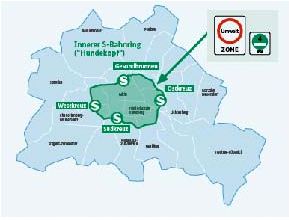Today we review measures undertaken by the national and municipal governments of Germany over the last decade or two to reduce air pollution particularly in its cities and particularly from transportation although initiatives are also in place to deal with wood combustion and ammonia from emissions from agriculture. Specific measures include Low Emission Zones and application of road pricing, restrictions for parking and lower speed limits of 30 kph on major roads. The result is that air quality in German cities today are as high as in rural areas 20 years ago. Future challenges include reducing greenhouse gas emissions to meet EU targets and reducing NO2 and PM emissions from diesel powered vehicles.

Key Quotes:
“The German government bases air pollution control on four strategies:
- laying down environmental quality standard
- emission reduction requirements according to the best available technology
- product regulations
- laying down emission ceilings”
“these successes were achieved by technologies like flue-gas desulfurization or the use of electrostatic precipitators and catalytic converters… enforced by emission standards, which are now mainly implemented at European Union level”
“the responsibility to meet air quality levels enables local or regional authorities to set up air quality plans containing various measures to improve air quality. Well-known examples for local measures are Low Emission Zones, which exclude vehicles with low emission standards from areas within the zone…. Lorry per toll rates in Germany vary between €0.14 and € 0.29 per km depending on environmental performance.”
“The Convention on Long-range Transboundary Air Pollution is an example how states can cooperate to reduce air pollution. Commitments not to emit more than a given total amount of a pollutant are instruments which can be used within these international conventions.”
“Beside the reduction of emissions from classical sectors like traffic and industrial plants, several other fields of action have been identified. These include the reduction of particle emissions from non-road mobile machinery and domestic wood combustion as well as the reduction of ammonia emissions from agriculture”
"A municipal air quality plan comprises all emissions sources like transport, industry, power generation and households.Based on emission and exposure models of the two main pollutants PM and NO2 , air quality measures are derived…the most important component is to make car transport less attractive by means of e.g. speed limits, restrictive parking management and pricing schemes.”
“Low Emission Zone (LEZ): Reduction potentials to reduce concentration levels for LEZs highly depend on the level of access restriction. Evaluation studies of actual LEZ implemented in the years 2008–2011 result in reduction potentials of up to 10 % for NO2 , 7 % for PM10 and 10 % for PM2.5 . A high reduction potential of up to 19 % for soot (black carbon) is particularly mentioned”
“Speed limits of 30 or 40 km/h on major roads ..Reducing speed limits on major roads from 50 to 30 or 40 km/h is a measure that is especially difficult to quantify. For the additional concentration caused by road traffic, reduction potentials for road traffic of 18 % for NOX , 15 % for NO2 and 30 % for PM10 are given.”
“What are the remaining challenges and priorities for Germany?
- climate change, in this area we still have a lot to do with regard to the further reduction of CO2 as well as of short-term climate factors like black carbon, soot, fluorocarbon or methane.
- problems with the amount of particulate matter.
-
· especially in urban canyons we have problems with nitrogen dioxide (NO2 ) emitted by diesel-powered vehicles because of wrong incentives and misguiding regulations are still in place.”
No comments:
Post a Comment